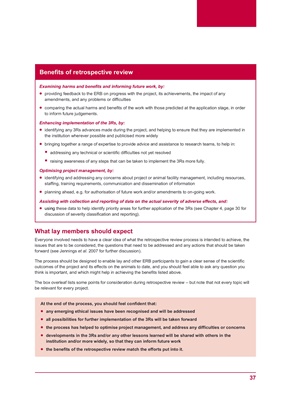
37
What lay members should expect
Everyone involved needs to have a clear idea of what the retrospective review process is intended to achieve, the
issues that are to be considered, the questions that need to be addressed and any actions that should be taken
forward (see Jennings et al. 2007 for further discussion).
The process should be designed to enable lay and other ERB participants to gain a clear sense of the scientific
outcomes of the project and its effects on the animals to date, and you should feel able to ask any question you
think is important, and which might help in achieving the benefits listed above.
The box overleaf lists some points for consideration during retrospective review - but note that not every topic will
be relevant for every project.
Benefits of retrospective review
Examining harms and benefits and informing future work, by:
providing feedback to the ERB on progress with the project, its achievements, the impact of any
amendments, and any problems or difficulties
comparing the actual harms and benefits of the work with those predicted at the application stage, in order
to inform future judgements.
Enhancing implementation of the 3Rs, by:
identifying any 3Rs advances made during the project, and helping to ensure that they are implemented in
the institution wherever possible and publicised more widely
bringing together a range of expertise to provide advice and assistance to research teams, to help in:
addressing any technical or scientific difficulties not yet resolved
raising awareness of any steps that can be taken to implement the 3Rs more fully.
Optimising project management, by:
identifying and addressing any concerns about project or animal facility management, including resources,
staffing, training requirements, communication and dissemination of information
planning ahead, e.g. for authorisation of future work and/or amendments to on-going work.
Assisting with collection and reporting of data on the actual severity of adverse effects, and:
using these data to help identify priority areas for further application of the 3Rs (see Chapter 4, page 30 for
discussion of severity classification and reporting).
At the end of the process, you should feel confident that:
any emerging ethical issues have been recognised and will be addressed
all possibilities for further implementation of the 3Rs will be taken forward
the process has helped to optimise project management, and address any difficulties or concerns
developments in the 3Rs and/or any other lessons learned will be shared with others in the
institution and/or more widely, so that they can inform future work
the benefits of the retrospective review match the efforts put into it.